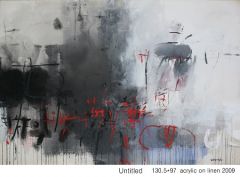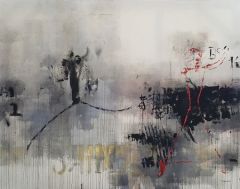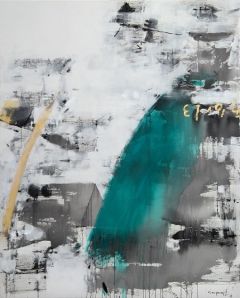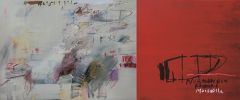| |

| |
|
[서양화] 고영일ㅣ Ko Young Il |
4118 |
|
트랙백 주소 : http://artiaco.com/home/bbs/tb.php/mgallery/279
|
|
Ko young-il
Seoul National Teacher’s Collage
Collage of Art University of Delhi(B.F.A)
Selected Solo & group exhibitions
16times Solo exhibitions
16times Solo exhibitions
Over 200times, participated in various exhibitions in Korea & abroad
Particularly he had a fabulous experience in 1994, when he was young, over 20pcs of his artworks have amazingly sold out in Basel Art Fair, following participated in FIAC,France, Koln Art Fair etc. His particular artworks are based in kind of oriental philosopical discourse and inspired from primitive thing and oriental myth, that draw by showing ambiguity between exquisite brush stroke and its automatical form and line gestures on surface of linen canvas. Currently, he became one of outstanding artist in Korea with critical acclaimed, accordingly he maintains brilliant reputation in major international art fairs , as well as domestic art market, remained historically in Korean art scene so far which is differenated factor of him as regarding aesthetic with extraordinary view compared than any artists. It would be defined that his paintings are normal an abstract expressionism where just speed and dance but combined in meditating with profound something primitive and pure nature inside them what we could imagine from the myth, with his authority is one of exclusive representing artist in Korea.
Art Fairs
Scope Art Show New York 2020
Miami Scope Art Fair 2019
AAF Amsterdam 2019
MANIF, Seoul Art Center(1996~1998,2002,2004, 2007, 2009~2014), Seoul
Art Chicago, Navy Pier, Chicago(2003)
Koln Art Fair, Koln MESSE, Germany(1996)
NICAF, Yokohama, Japan(1994)
Basel Art Fair, Basel, swiss(1994)
FIAC, Grand Palais, Paris(1993)
Awards
the Grand Prize at the MANIF2!96(1996)
the 2nd Prize at the Korean Arts Exhibition(1985)
Peindre contre / Critic
Philippe Dagen
For more than a century, Western painters have been looking in the direction of the Far East, asking him for clear and vigorous legends, and so much so much so that they cling to the prints of calligraphy, usually superficial references, all the more superficial.he paintings are very ignorant of the meaning and practice of this discipline. They thought it was an abstract expressionism where speed and dance were combined - an alphabet of empty signs where their passions and gestures could be inscribed. They took possession of it, at the risk of altering it and tracing it, at the risk of not realizing that this calligraphy was taking place.is not a seismography, it is much more about philosophy than drawing. Here is a Korean painter, Ko. It is the opposite of these modes, of this easy exoticism. His art is obvious, difficult, without ostentation or chatting to the image of his author, who does not pose to the artist. A strange artist, even with his biography. He had experience lived in India for several years. He once had his workshop in New-Delhi. It travels from the upper valley of the Indus to the south of the peninsula, through Rajasthan and Deccan. First that this exile. Why have left his native country for a city that is very close to all the circuits of contemporary art? Another peculiarity is that he is familiar with traditional Korean calligraphy, as well as with American and European painting of recent decades. And yet his art is neither rehearsal nor compromise; it does not belong to any academy. It looks like nothing known. It is a free attempt at identifying precedents and models. Attempts to understand and decrypt what he sees, what he feels, what makes him feel and keeps him. ( Among critic )
Depuis plus d’un siècle, les peintres occidentaux regardant dans la direction de l’orient lointain, ils lui demandent des leçons de netteté et vigueur, ils se reclament tantôt des estampes tantôt de la calligraphie, références d’ordinaire superficielles, d’autant plus superficielles que la plupart de ces peintures ignorant à peu près tout du sens et de la pratique de cette discipline. Ils ont cru y voit un expressionnisme abstrait où vitesse et danse s’allient -un alphabet de signes vacants où leurs passions et leurs gestes pouvaient s’inscrire ils en ont pris possession, à la légère, au risque de l’altérer et de le travestir, au risque de ne pas s’apercevoir que cette calligraphie n’est pas une sismorgraphie, qu’elle tient bien plus de la philosophie que du dessin. Voici un peintre coréen, Ko. Il est à l’opposé de ces modes, de cet exotisme facile. Son art est sévère, difficile, sans ostentation ni bavardage à l’image de son auteur du reste, qui ne pose pas à l’artiste. Etrange artiste du reste, jusque par sa biographie. Il vit depuis plusieurs années en Inde. Il a son atelier à New-Delhi. Il voyage de la haute vallée de l’Indus jusqu’au sud de la péninsule, à travers le Rajasthan et le Deccan. Première étrageté que cet exil. Pourquoi avoir quitté son pays natal pour une ville très à l’ecart de tous les circuits de l’art contemporain? Autre singularité : il connaît la calligraphie traditionnelle coréenne et il n’ignore pas non plus la peinture américaine et eurepéenne des dernières décennies. Et cependant son art n’est ni de répétition ni de compromis, il ne relève d’aucun académisme. Il ne ressemble à rien de connu. C’est une tentative libre de précédents et de modèles identifiables. Tentative de quoi ? De compréhension et de déchiffrement de ce qu’il voit, de ce qu’il ressent, de ce qui l’ébranle et le retient.
D’un lieu, que ce lieu soit une région de l’Inde ou un pays rêvé, il ne tire pas la matière d’un paysage, ni d’une description, pas plus qu’il ne se satisfait de quelques formes symboliques, de quelques signes allusifs. Il ne se veut en somme ni exactement figuratif, ni définitivement abstrait – et ces catégories non, dans doute, guère d’importance à ses yeux, pas plus que les débats interminables qu’elles ont suscités entre chapelles et partis en Europe et aux Etat-Unis. Il cherche, à sa manière, à son rythme, un passage vers ce qu’il faut appeler, faute d’autre mot, la réalité. Chaque tableau est cette avancée, lisible clairement.
|
 |
| the Myth 2_182x227_acrylic on canvas_1996 |
|
 |
| the Myth 1_182x227_acrylic on canvas_1996 |
|
 |
| landscape_100F_acrylic on canvas_2018[01 |
|
 |
| 1-3 Ko Young Il,Myth, 120X260cm, Acrylic om canvas |
|
 |
| scenery,89x130cm,acrylic on canvas,2020 |
|
|
|
 |
|
|
|
|
|
|


